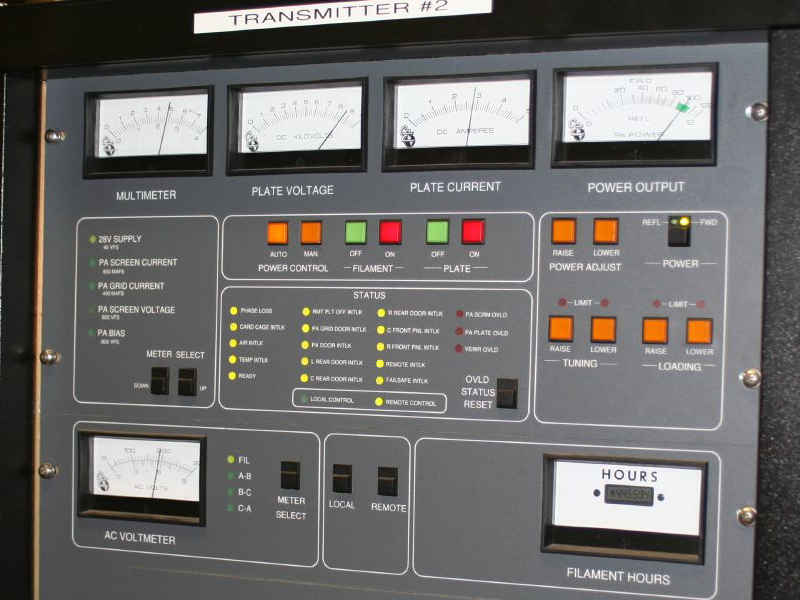|
KVET (AM)
KVET (1300 kHz) is an Austin, Texas AM radio station. It is owned by iHeartMedia, and carries a sports radio format with both local sports shows and programming from Fox Sports Radio. KVET uses a directional antenna, broadcasting at 5,000 watts to the northwest over the Texas Hill Country during the daytime and 1,000 watts to the south over central Austin at night. The transmitter site is just a few miles north of downtown, on Metric Boulevard. KVET shares studios and offices with four other sister stations in the Penn Field complex in the South Congress district (or "SoCo") of south central Austin, within walking distance of St. Edward's University. History Austin's third radio station With the end of World War II, a group of ten Texas veterans organized as the Austin Broadcasting Company and pooled their resources to start a radio station in Austin. After obtaining a construction permit on December 13, 1945, they chose a call sign that included the word "vet". KVET signed o ... [...More Info...] [...Related Items...] OR: [Wikipedia] [Google] [Baidu] |
Austin, Texas
Austin is the capital city of the U.S. state of Texas, as well as the county seat, seat and largest city of Travis County, Texas, Travis County, with portions extending into Hays County, Texas, Hays and Williamson County, Texas, Williamson counties. Incorporated on December 27, 1839, it is the List of United States cities by population, 11th-most-populous city in the United States, the List of cities in Texas by population, fourth-most-populous city in Texas, the List of capitals in the United States, second-most-populous state capital city, and the most populous state capital that is not also the most populous city in its state. It has been one of the fastest growing large cities in the United States since 2010. Downtown Austin and Downtown San Antonio are approximately apart, and both fall along the Interstate 35 corridor. Some observers believe that the two regions may some day form a new "metroplex" similar to Dallas–Fort Worth metroplex, Dallas and Fort Worth. Austin i ... [...More Info...] [...Related Items...] OR: [Wikipedia] [Google] [Baidu] |
KHFI-FM
KHFI-FM (96.7 MHz) is a commercial radio station licensed to Georgetown, Texas, and serving the Greater Austin radio market. Owned by iHeartMedia, Inc., it airs a Top 40/CHR radio format, branded as "KISS-FM." It shares studios and offices with other iHeart stations in the Penn Field complex in the South Congress district (or "SoCo") of south central Austin within walking distance of St. Edward's University. It had previously been located in a downtown Austin office building off Barton Springs Road. KHFI-FM broadcasts with an effective radiated power (ERP) of 100,000 watts, from a transmitter located off Waymaker Way in Austin, amid numerous towers for other FM and TV stations. KHFI-FM broadcasts in the HD Radio format. History KGTN-FM and KQFX 96.7 signed on from Georgetown as KGTN-FM on March 1, 1972. It was co-owned with KGTN (1530 AM, now KZNX), the town's daytime-only AM station, and broadcast with 3,000 watts, providing nighttime service to extend KGTN's broadcast ... [...More Info...] [...Related Items...] OR: [Wikipedia] [Google] [Baidu] |
Call Sign
In broadcasting and radio communications, a call sign (also known as a call name or call letters—and historically as a call signal—or abbreviated as a call) is a unique identifier for a transmitter station. A call sign can be formally assigned by a government agency, informally adopted by individuals or organizations, or even cryptographically encoded to disguise a station's identity. The use of call signs as unique identifiers dates to the landline railroad telegraph system. Because there was only one telegraph line linking all railroad stations, there needed to be a way to address each one when sending a telegram. In order to save time, two-letter identifiers were adopted for this purpose. This pattern continued in radiotelegraph operation; radio companies initially assigned two-letter identifiers to coastal stations and stations onboard ships at sea. These were not globally unique, so a one-letter company identifier (for instance, 'M' and two letters as a Marcon ... [...More Info...] [...Related Items...] OR: [Wikipedia] [Google] [Baidu] |
South Congress
South Congress (abbreviated SoCo) is a neighborhood located on South Congress Avenue in Austin, Texas, United States. It is also a nationally known shopping and cultural district known for its many eclectic small retailers, restaurants, music and art venues and, more recently, food trucks. South Congress begins at the Colorado River and Ann W. Richards Congress Avenue Bridge and runs due south towards Ben White Boulevard/TX-71. The area is bordered by two historic South Austin neighborhoods: Travis Heights to the east and Bouldin Creek to the west. Since its humble beginnings in the 1850s, South Congress Avenue has been transformed from a rural country road to the capital city gateway and, finally, to the shopping district that it is today. Some Austinites attribute its enduring popularity to the unobstructed view of the Texas State Capitol. History Edwin Waller designed Congress to be Austin's most prominent thoroughfare in the 1830s. However, Congress did not extend south ... [...More Info...] [...Related Items...] OR: [Wikipedia] [Google] [Baidu] |
Sister Station
In broadcasting, sister stations or sister channels are radio or television stations operated by the same company, either by direct ownership or through a management agreement. Radio sister stations will often have different formats, and sometimes one station is on the AM band while another is on the FM band. Conversely, several types of sister-station relationships exist in television; stations in the same city will usually be affiliated with different television networks (often one with a major network and the other with a secondary network), and may occasionally shift television programs between each other when local events require one station to interrupt its network feed. Sister stations in separate (but often nearby) cities owned by the same company may or may not share a network affiliation. For example, WNYW and WWOR-TV, in New York City and Secaucus, New Jersey, are both owned by Fox Corporation. WNYW is a Fox owned-and-operated station; WWOR-TV is a MyNetworkTV ow ... [...More Info...] [...Related Items...] OR: [Wikipedia] [Google] [Baidu] |
Transmitter
In electronics and telecommunications, a radio transmitter or just transmitter is an electronic device which produces radio waves with an antenna. The transmitter itself generates a radio frequency alternating current, which is applied to the antenna. When excited by this alternating current, the antenna radiates radio waves. Transmitters are necessary component parts of all electronic devices that communicate by radio, such as radio and television broadcasting stations, cell phones, walkie-talkies, wireless computer networks, Bluetooth enabled devices, garage door openers, two-way radios in aircraft, ships, spacecraft, radar sets and navigational beacons. The term ''transmitter'' is usually limited to equipment that generates radio waves for communication purposes; or radiolocation, such as radar and navigational transmitters. Generators of radio waves for heating or industrial purposes, such as microwave ovens or diathermy equipment, are not usually called transmi ... [...More Info...] [...Related Items...] OR: [Wikipedia] [Google] [Baidu] |
Texas Hill Country
The Texas Hill Country is a geographic region of Central and South Texas, forming the southeast part of the Edwards Plateau. Given its location, climate, terrain, and vegetation, the Hill Country can be considered the border between the American Southeast and Southwest. The region represents the very remote rural countryside of Central Texas, but also is home to growing suburban neighborhoods and affluent retirement communities. The region is notable for its karst topography and tall rugged hills of limestone or granite. Many of the hills rise to a height of above the surrounding plains and valleys, with Packsaddle Mountain rising to a height of above the Llano River in Kingsland. The Hill Country also includes the Llano Uplift and the second-largest granite dome in the United States, Enchanted Rock. The terrain throughout the region is characterized by a thin layer of topsoil and many exposed rocks and boulders, making the region very dry and prone to flash flooding ... [...More Info...] [...Related Items...] OR: [Wikipedia] [Google] [Baidu] |
Directional Antenna
A directional antenna or beam antenna is an antenna which radiates or receives greater power in specific directions allowing increased performance and reduced interference from unwanted sources. Directional antennas provide increased performance over dipole antennas—or omnidirectional antennas in general—when greater concentration of radiation in a certain direction is desired. A high-gain antenna (HGA) is a directional antenna with a focused, narrow radiowave beam width, permitting more precise targeting of the radio signals. Most commonly referred to during space missions, these antennas are also in use all over Earth, most successfully in flat, open areas where there are no mountains to disrupt radiowaves. By contrast, a low-gain antenna (LGA) is an omnidirectional antenna with a broad radiowave beam width, that allows the signal to propagate reasonably well even in mountainous regions and is thus more reliable regardless of terrain. Low-gain antennas are often used ... [...More Info...] [...Related Items...] OR: [Wikipedia] [Google] [Baidu] |
Radio Format
A radio format or programming format (not to be confused with broadcast programming) describes the overall content broadcast on a radio station. The radio format emerged mainly in the United States in the 1950s, at a time when radio was compelled to develop new and exclusive ways to programming by competition with television. The formula has since spread as a reference for commercial radio programming worldwide. A radio format aims to reach a more or less specific audience according to a certain type of programming, which can be thematic or general, more informative or more musical, among other possibilities. Radio formats are often used as a marketing tool and are subject to frequent changes. Except for talk radio or sports radio formats, most programming formats are based on commercial music. However the term also includes the news, bulletins, DJ talk, jingles, commercials, competitions, traffic news, sports, weather and community announcements between the tracks. Backgroun ... [...More Info...] [...Related Items...] OR: [Wikipedia] [Google] [Baidu] |
Radio Station
Radio broadcasting is transmission of audio (sound), sometimes with related metadata, by radio waves to radio receivers belonging to a public audience. In terrestrial radio broadcasting the radio waves are broadcast by a land-based radio station, while in satellite radio the radio waves are broadcast by a satellite in Earth orbit. To receive the content the listener must have a broadcast radio receiver (''radio''). Stations are often affiliated with a radio network which provides content in a common radio format, either in broadcast syndication or simulcast or both. Radio stations broadcast with several different types of modulation: AM radio stations transmit in AM ( amplitude modulation), FM radio stations transmit in FM (frequency modulation), which are older analog audio standards, while newer digital radio stations transmit in several digital audio standards: DAB (digital audio broadcasting), HD radio, DRM ( Digital Radio Mondiale). Television bro ... [...More Info...] [...Related Items...] OR: [Wikipedia] [Google] [Baidu] |
AM Radio
AM broadcasting is radio broadcasting using amplitude modulation (AM) transmissions. It was the first method developed for making audio radio transmissions, and is still used worldwide, primarily for medium wave (also known as "AM band") transmissions, but also on the longwave and shortwave radio bands. The earliest experimental AM transmissions began in the early 1900s. However, widespread AM broadcasting was not established until the 1920s, following the development of vacuum tube receivers and transmitters. AM radio remained the dominant method of broadcasting for the next 30 years, a period called the "Golden Age of Radio", until television broadcasting became widespread in the 1950s and received most of the programming previously carried by radio. Subsequently, AM radio's audiences have also greatly shrunk due to competition from FM ( frequency modulation) radio, Digital Audio Broadcasting (DAB), satellite radio, HD (digital) radio, Internet radio, music streaming ser ... [...More Info...] [...Related Items...] OR: [Wikipedia] [Google] [Baidu] |




